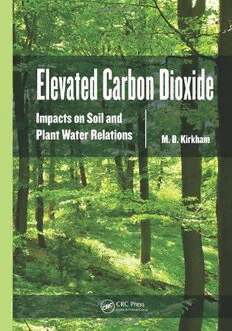
Elevated Carbon Dioxide: Impacts on Soil and Plant Water Relations PDF
406 Pages·2011·8.688 MB·English
Most books are stored in the elastic cloud where traffic is expensive. For this reason, we have a limit on daily download.
Preview Elevated Carbon Dioxide: Impacts on Soil and Plant Water Relations
Description:
Between 1958 and 2008, the CO2 concentration in the atmosphere increased from 316 to 385 ppm. Continued increases in CO2 concentration will significantly affect long-term climate change, including variations in agricultural yields. Focusing on this critical issue, Elevated Carbon Dioxide: Impacts on Soil and Plant Water Relations presents research conducted on field-grown sorghum, winter wheat, and rangeland plants under elevated CO2. It describes specific results from pioneering experiments performed over a seven-year period in the Evapotranspiration Laboratory at Kansas State University, along with experiments appearing in peer-reviewed journal articles. Select articles from the literature serve as examples in the text. For each paper discussed, the author includes the common and scientific name of the plant under investigation. For each experiment, the author provides the type of soil used (if given in the original article) and general conditions of the experiment. All references are carefully documented so that readers can easily find the original source. The first chapter of the book deals with drought, the three types of photosynthesis, and how water moves through the soil–plant–atmosphere continuum. With a focus on soil, the next several chapters discuss the composition of the soil atmosphere, the interaction of elevated CO2 with physical factors that affect root growth, variable oxygen concentration of soil, and when the atmosphere above soil is elevated with CO2. The author goes on to examine the use of carbon isotope ratios in plant science; the effects of elevated CO2 on plant water, osmotic, and turgor potentials; and stomata under elevated CO2, including stomatal conductance and density. The text also explains the effects of elevated CO2 on transpiration and evapotranspiration, explores historical aspects of water use efficiency, compares C3 and C4 plants under elevated CO2, and details the advantages of C4 photosynthesis. The concluding chapters cover plant anatomy, the effects of elevated CO2 on phenology, and measures of plant growth. How have plants responded to increased levels of atmospheric CO2? Are some plants reacting better than others? Drawing on a host of scientific studies, this text explores how rising levels of CO2 in the atmosphere have impacted water in plants and soils.
See more
The list of books you might like
Most books are stored in the elastic cloud where traffic is expensive. For this reason, we have a limit on daily download.
